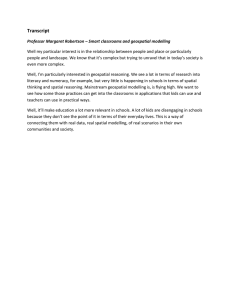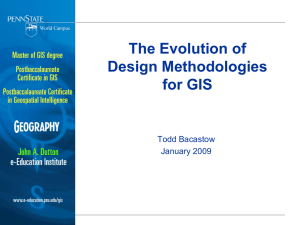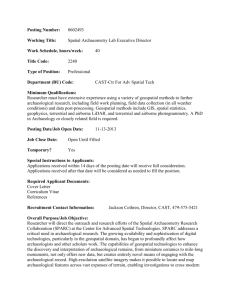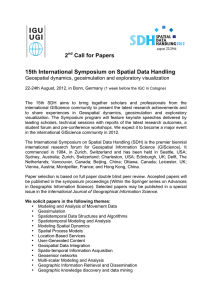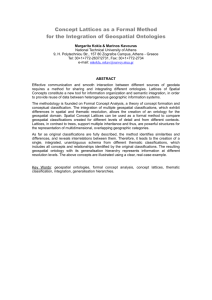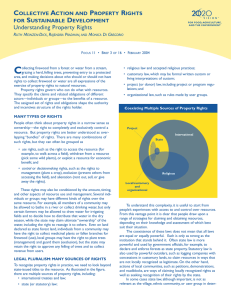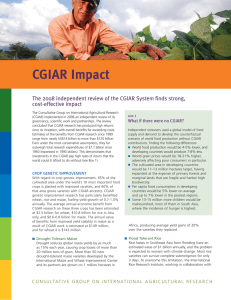Location Intelligence
advertisement
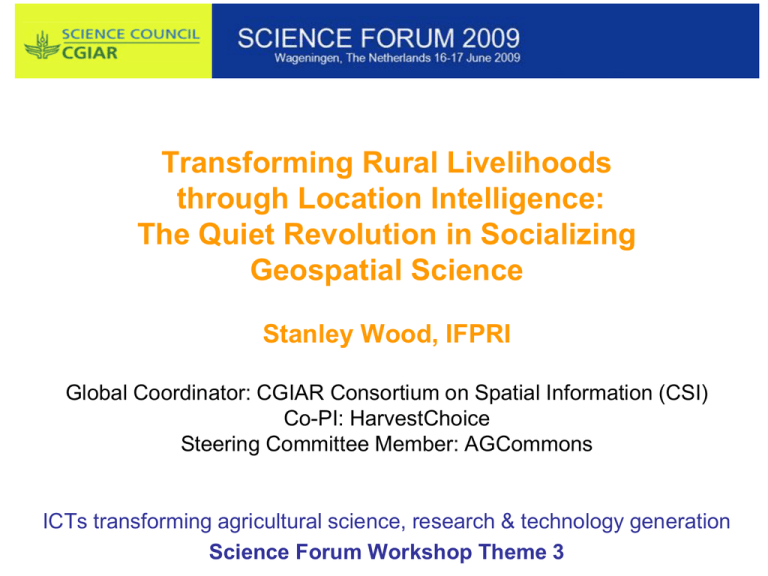
Transforming Rural Livelihoods through Location Intelligence: The Quiet Revolution in Socializing Geospatial Science Stanley Wood, IFPRI Global Coordinator: CGIAR Consortium on Spatial Information (CSI) Co-PI: HarvestChoice Steering Committee Member: AGCommons ICTs transforming agricultural science, research & technology generation Science Forum Workshop Theme 3 Definitions & Examples • Location Intelligence: The place-specific insights gained by organizing and analyzing complex phenomena using geographic attributes and relationships found in all information. By combining geographic- and location-related data with HH data, rural poor (especially) can gain new insights, make better decisions, and fine tune important processes and applications. Examples: best varieties & planting windows; best practices; local prices; input availability; marketing opportunities (product, land, machine, labour); infrastructure siting & design, investment targeting Driving Forces • Rapid growth in converging & mutually supporting infrastructure/hardware platforms: $1 GPS chips; lowpower rugged PDAs; cell phone networks; fiber-optic cable; nanotechnologies; private & developing country RS expansion; resolution, spectral, repeat, processing & access; advanced servers & cloud/grid computing. • Explosion of “neogeography” business & consumeroriented, geospatial applications & tools: Google, Bing; FOSS & OpenGIS; Satnav & visualization tools, “Mashups”, links to, e.g., photo/doc data & models. Web-based spatial data sharing, value-addition, e.g., Geo commons. • Socializing of Geography; GPS ubiquity; Web 2.0 linkages; increasingly spatially-aware public as GIS/RS technicians/consumers, crowdsourcing (Openstreetmap) Development Opportunities • Enhanced two-way flow of timely, highly-targeted, location-specific and location-intelligent information, e.g., use of CG outputs in “last 10km” • Value-addition by integration/synthesis/modeling services & delivery of location-intelligence • Validation and expert elicitation of local data • ‘Public as sensors’ lay data collection, e.g., Kenya: cell phone a/c credited for delivered data points • More RS for land use, production, environmental systems, infrastructure, M&E (change detection), statistics (crop system area & yield detection). • Value chain spatial tracking (safety, certification) Science & Development Issues • Critical gaps in understanding current and potential location-specific & time-specific user information needs. • Licensing strategies to promote public goods sharing & attribution, & promote innovation by public & private sector • Protocols for respecting privacy of individuals and households • Cell/web access limits (coverage/bandwidth) in rural areas • ICT access impacts on power structures (PPGIS lessons) • Integration of socio-economic data (especially with rapidly changing administrative boundaries) • Enabling local institutional capacity for service provision • Quality assurance strategies with crowd-sourced data • Business models for sustainable location-intelligence service provision Location Intelligence & CGIAR MPs • Enabling Environment: Critical need for support for awareness & capacity development, sustain internal CoP linked to key partners, foster the harmonization & sharing of data, tools, protocols. Assess need to develop and sustain shared spatial infrastructure (Actors include; CSI, ICT/KM, AGCommons) • Cross-cutting Geospatial Service Provision: “Plug and P(l)ay” geospatial service modules/capacities supporting individual MPs; map visualization, strategic geographic targeting, spatial sampling design, location-intelligent value adding services, scaling-up/out location-specific research • Advanced Location-intelligent Research Methods: Increased embedding of spatial analysis tools into the general research armoury of MP researchers to improve robustness and significance of research findings. More Information • • • • • • s.wood@cgiar.org CGIAR Centre Representatives www.agcommons.org www.harvestchoice.org www.geocommons.com (http://csi.cgiar.org/index.asp) under reconstruction
